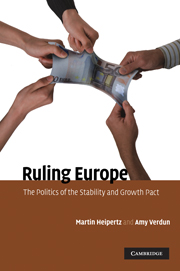Book contents
- Frontmatter
- Contents
- List of tables
- Foreword by Jean-Claude Juncker, Prime Minister of Luxembourg and President of the Eurogroup
- Preface
- Acknowledgements
- List of abbreviations
- 1 The politics of the Stability and Growth Pact
- Part I
- Part II
- 6 Implementation of the SGP in good and in bad times
- 7 From bad times to crisis
- 8 The SGP before the European Court of Justice
- 9 The SGP in times of financial turbulence and economic crisis
- 10 Conclusion: The past, present and future of the SGP and implications for European integration theory
- Appendix
- Bibliography
- Index
10 - Conclusion: The past, present and future of the SGP and implications for European integration theory
Published online by Cambridge University Press: 06 July 2010
- Frontmatter
- Contents
- List of tables
- Foreword by Jean-Claude Juncker, Prime Minister of Luxembourg and President of the Eurogroup
- Preface
- Acknowledgements
- List of abbreviations
- 1 The politics of the Stability and Growth Pact
- Part I
- Part II
- 6 Implementation of the SGP in good and in bad times
- 7 From bad times to crisis
- 8 The SGP before the European Court of Justice
- 9 The SGP in times of financial turbulence and economic crisis
- 10 Conclusion: The past, present and future of the SGP and implications for European integration theory
- Appendix
- Bibliography
- Index
Summary
This study of the Stability and Growth Pact has sought to provide an in-depth analysis of the SGP case while at the same time it aimed to use integration theories to make sense of the empirical findings. Many EU studies are either empirically well informed but fall short of exploiting the theoretical insights that could be obtained, or, alternatively, are strictly interested in improving the theory while resting on thin empirics. This chapter seeks to bring together the insights from more than a dozen years of SGP history with our take on how better to use theories of European integration for understanding integration phenomena.
The SGP has already attracted more attention than its founders ever thought it would during its entire existence. It has proven to be a Pact caught up in politics, both domestic and international, and firmly embedded in the functional framework of the EU with a large role played by experts and the existing paradigm on economic policy-making.
This study sought to trace the origins of the Stability and Growth Pact, its implementation, its institutional crisis and reform and its implementation in the midst of a global economic crisis – all with a view to understanding what factors determine the outcomes we observe. Reflecting briefly on the financial crisis we speculated on what it might mean for the SGP. In this book we adopted an innovative approach by having parts of the Pact's genesis be analysed by different theoretical approaches, which we argue are complementary in their power to explain the outcome.
- Type
- Chapter
- Information
- Ruling EuropeThe Politics of the Stability and Growth Pact, pp. 196 - 204Publisher: Cambridge University PressPrint publication year: 2010

